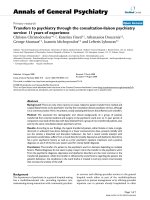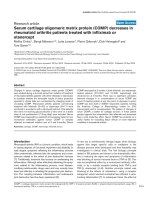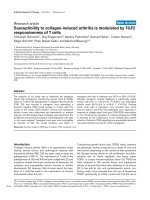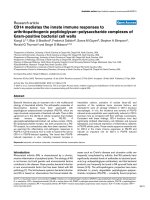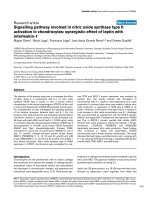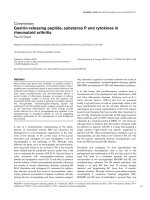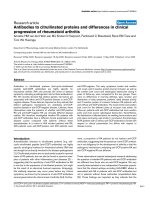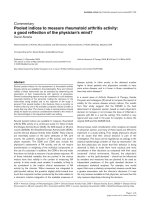Báo cáo y học: "Response to the commentary ‘Pooled indices to measure rheumatoid arthritis activity: a good reflection of the physician’s mind" pdf
Bạn đang xem bản rút gọn của tài liệu. Xem và tải ngay bản đầy đủ của tài liệu tại đây (32.19 KB, 2 trang )
Page 1 of 2
(page number not for citation purposes)
Available online />The February issue of Arthritis Research & Therapy included
a commentary by Aletaha [1] on a recent report from our
group [2].
First, Aletaha states that evaluation of the ‘physician’s mind’ is
best performed in a study setting in which the physician is
unaware that their clinical decision is part of the investigation.
It should be noted that the analysis we reported [2] was a
post hoc analysis on a cohort of patients with rheumatoid
arthritis (RA) who began infliximab therapy within the context
of an expanded access programme, and in which infliximab
therapy was provided for free until reimbursement in 2002. In
the initial protocol it was pre-specified that, from week 30
onward, patients with insufficient response to the therapy
could receive an extra vial at each infusion. This decision had
to be taken at week 22 and was based on the treating
rheumatologist’s appreciation of the patient’s condition and
disease activity. Because the analysis presented in our report
was not planned for in the initial protocol, a post hoc
amendment to the initial protocol for our analysis was
approved by the ethical committee in 2004. Thus, at the time
of the study, the physicians were unaware that their behaviour
would be evaluated in a separate analysis.
Second, we should like to clarify that the components of the
American College of Rheumatology (ACR) core set response
score and the Disease Activity Score (DAS28) were known
to the treating physician, but not the calculated values of the
ACR core set response score and DAS28.
A third issue highlighted by Aletaha [1] and by Van Riel and
Fransen [3] is that in our study more than 50% of patients did
not receive a dose increase, even though those patients had
a DAS28 score greater than 3.2, indicating moderate or high
disease activity. It can therefore be questioned why
physicians ‘neglected’ to treat their patients more
aggressively. It should be noted that the patients included in
the study had long-standing destructive disease (median
disease duration 10 years) and had previously failed to
respond to aggressive therapy, as reflected by a failure to
respond to a median of four disease-modifying antirheumatic
drugs. Infliximab therapy was for most patients the final
therapeutic option at the time of the study, and for such
individuals and their physicians moderate disease activity was
acceptable, representing an improvement over their previous
state. Sokka and Makinen [4] recently suggested that when
more treatment options become available, lower levels of RA
disease activity will be required. Also, it should be mentioned
that the study was a reflection of real life practice for an
important number of rheumatologists, because about half of
all Belgian rheumatologists were involved in this large
multicentre study.
Aletaha [1] also suggests that the DAS28 score places
undue emphasis on erythrocyte sedimentation rate (ESR),
and thus it may misrepresent disease activity in the lower
ranges [2,5,6]. We evaluated coefficients and weighting of
the DAS28 score by means of a discriminant analysis. The
coefficients obtained by discriminant analysis were similar to
Letter
Response to the commentary ‘Pooled indices to measure
rheumatoid arthritis activity: a good reflection of the physician’s
mind’
Bert Vander Cruyssen
1
, Patrick Durez
2
, Rene Westhovens
3
, Nathan Vastesaeger
4
, Anja Geldhof
5
and Filip De Keyser
1
1
Rheumatology, Ghent University Hospital, Belgium
2
Rheumatology, Cliniques Universitaires Saint-Luc, Brussels, Belgium
3
Rheumatology, University Hospitals KULeuven, Leuven, Belgium
4
Medical affaires, Schering Plough, Brussels, Belgium
5
Medical affaires, Centocor, Leiden, the Netherlands
Corresponding author: Bert Vander Cruyssen,
Published: 10 October 2006 Arthritis Research & Therapy 2006, 8:406 (doi:10.1186/ar2044)
This article is online at />© 2006 BioMed Central Ltd
See related commentary by Aletaha, related research article by Vander Cruyssen et al.,
and related commentary by van Riel and Fransen, />Page 2 of 2
(page number not for citation purposes)
Arthritis Research & Therapy Vol 8 No 6 Vander Cruyssen et al.
the coefficients of the DAS28. A 20% difference was
observed for the coefficient of ESR (Table 1), suggesting that
ESR might be slightly over-weighted in the DAS28. In our
study, this difference in weight of the ESR did not induce a
significant difference between the discriminant score and the
DAS28. The absolute difference between the discriminant
score and the DAS28 was similar in the higher and the lower
ranges of disease activity.
Finally, we agree that the different DAS variants may have
strengths in specific situations. In our analysis, we found that
the DAS28-ESR correlated slightly better with the decision to
give a dose increase than the other 28 joint count disease
activity scores, including Simplified Disease Activity Index
(SDAI) and Clinical Disease Activity Index (CDAI). This
appears to contradict the findings of Soubrier and coworkers
[7], who found that the SDAI performed better than the
DAS28-ESR. An important difference between that study and
ours is that our study was multicentre and that reported by
Soubrier and coworkers was a monocentre study. In a
monocentre study, it is intuitive that the SDAI will correlate
better with the physician’s decision than the DAS28 because
the SDAI includes the physician’s global visual-analogue
scale (VAS). In contrast, in a multicentre study the physician’s
global VAS may be subject to interobserver and intercentre
variability. These sources of variability may explain why the
SDAI performed slightly worse than the DAS28 in our
multicentre study; the DAS28 does not include the
physician’s global VAS and weights the swollen joint count
lower than the SDAI.
To conclude, the analysis that we performed supports the
validity of the DAS28 score for measuring disease activity in
the follow up of RA patients undergoing anti-tumour necrosis
factor treament. Variants of the DAS28 have been described,
and each variant may have pros and cons in certain
situations.
Competing interests
The authors declare that they have no competing interests.
References
1. Aletaha D: Pooled indices to measure rheumatoid arthritis
activity: a good reflection of the physician’s mind? Arthritis
Res Ther 2006, 8:102.
2. Vander Cruyssen B, Van Looy S, Wyns B, Westhovens R, Durez
P, Van den Bosch F, Veys EM, Mielants H, De Clerck L, Peretz A,
et al.: DAS28 best reflects the physician’s clinical judgment of
response to infliximab therapy in rheumatoid arthritis
patients: validation of the DAS28 score in patients under
infliximab treatment. Arthritis Res Ther 2005, 7:R1063-R1071.
3. van Riel PL, Fransen J: DAS28: a useful instrument to monitor
infliximab treatment in patients with rheumatoid arthritis.
Arthritis Res Ther 2005, 7:189-190.
4. Sokka T, Makinen H: Improving outcomes in rheumatoid arthri-
tis: what determines decisions to change ineffective therapy?
J Rheumatol 2006, 33:1213-1215.
5. Makinen H, Kautiainen H, Hannonen P, Sokka T: Is DAS28 an
appropriate tool to assess remission in rheumatoid arthritis?
Ann Rheum Dis 2005, 64:1410-1413.
6. Aletaha D, Nell VP, Stamm T, Uffmann M, Pflugbeil S, Machold K,
Smolen JS: Acute phase reactants add little to composite
disease activity indices for rheumatoid arthritis: validation of a
clinical activity score. Arthritis Res Ther 2005, 7:R796-R806.
7. Soubrier M, Zerkak D, Gossec L, Ayral X, Roux C, Dougados M:
Which variables best predict change in rheumatoid arthritis
therapy in daily clinical practice? J Rheumatol 2006, 33:1243-
1246.
Table 1
Coefficients of the DAS28-ESR versus the coefficients of the
discriminant score obtained in the study
Parameter DAS score Discriminant score
Sqrt(28 TJC) 0.56 0.52
Sqrt(28 SJC) 0.28 0.28
Ln(ESR) 0.70 0.56
Patient’s global VAS 0.014 0.025
DAS28, Disease Activity Score; ESR, erythrocyte sedimentation rate;
Ln, natural logarithm; SJC, swollen joint count; Sqrt, square root; TJC,
total joint count; VAS, visual-analogue scale.

